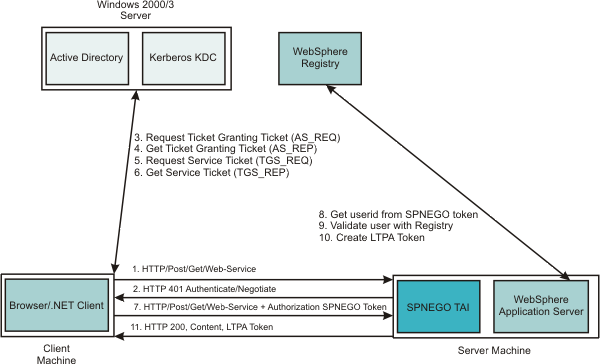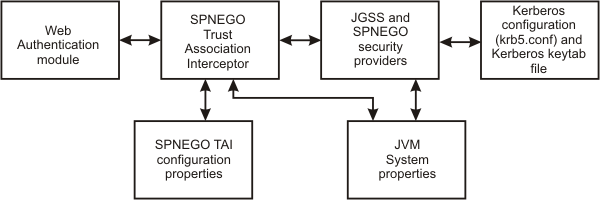Single sign-on for HTTP requests using SPNEGO TAI (deprecated)
WebSphere® Application Server provides a trust association interceptor (TAI) that uses the Simple and Protected GSS-API Negotiation Mechanism (SPNEGO) to securely negotiate and authenticate HTTP requests for secured resources in WebSphere Application Server.
In WebSphere Application Server Version 6.1, a trust association interceptor (TAI) that uses the Simple and Protected GSS-API Negotiation Mechanism (SPNEGO) to securely negotiate and authenticate HTTP requests for secured resources was introduced. In WebSphere Application Server 7.0, this function is now deprecated. SPNEGO web authentication has taken its place to provide dynamic reload of the SPNEGO filters and to enable fallback to the application login method.
Read about Creating a single sign-on for HTTP requests using SPNEGO Web authentication for more information.
SPNEGO is a standard specification defined in The Simple and Protected GSS-API Negotiation Mechanism (IETF RFC 2478).
HTTP users log in and authenticate only once at their desktop and are subsequently authenticated (internally) with WebSphere Application Server. The SPNEGO TAI is invisible to the end-user of WebSphere applications. The SPNEGO TAI is only visible to the web administrator who is responsible for ensuring a proper configuration, capacity, and maintenance of the web environment.
- A client application, for example, a browser or Microsoft .NET client, that supports the SPNEGO authentication mechanism, as defined in IETF RFC 2478. Microsoft Internet Explorer Version 5.5 or later and Mozilla Firefox Version 1.0 are browser examples. Any browser needs to be configured to use the SPNEGO mechanism. For more information on performing this configuration, see Configuring the client browser to use SPNEGO TAI (deprecated).
The challenge-response handshake process is illustrated in the following graphic:

- Setting up the Kerberos configuration properties. See The Kerberos configuration file.
- Setting or adjusting the SPNEGO TAI custom properties. See SPNEGO TAI custom properties configuration (deprecated).
- Adjusting the SPNEGO TAI filter settings. See Configuring JVM custom properties, filtering HTTP requests, and enabling SPNEGO TAI in WebSphere Application Server (deprecated)
- Using the custom login module to map the identity from the Active Directory to the WebSphere Application Server registry. See Mapping user Ids from client to server for SPNEGO.
- Setting the major and additional Java virtual machine (JVM) custom properties. See SPNEGO TAI JVM configuration custom properties (deprecated)
The web administrator has access to the following SPNEGO TAI security components and associated configuration data, as illustrated in the following graphic.

- The web authentication module and the Lightweight Third Party Authentication (LTPA) mechanism provide the plug-in runtime framework for trust association interceptors. See Configuring the LTPA mechanism for more detail is configuring the LTPA mechanism for use with the SPNEGO TAI.
- The Java Generic Security Service (JGSS) provider is included in the Java SDK (
jre/lib/ibmjgssprovider.jar
- The Kerberos configuration properties (
krb5.conforkrb5.ini) and Kerberos encryption keys (stored in a Kerberos keytab file) are used to establish secure mutual authentication.The Kerberos key table manager (Ktab), which is part of JGSS, allows you to manage the principal names and service keys stored in a local Kerberos keytab file. Principal name and key pairs listed in the Kerberos keytab file allow services running on a host to authenticate themselves to the Kerberos Key Distribution Center (KDC). Before a server can use Kerberos, a Kerberos keytab file must be initialized on the host that runs the server.
Using the ktab command to manage the Kerberos keytab file highlights the Kerberos configuration requirements for the SPNEGO TAI as well as the use of Ktab.
- The SPNEGO provider supplies the implementation of the SPNEGO
authentication mechanism, located at
/$WAS_HOME/java/jre/lib/ext/ibmspnego.jar.
- The custom configuration properties control the runtime behavior of the SPNEGO TAI. Configuration operations are performed with the administrative console or scripting facilities. Refer to SPNEGO TAI custom properties configuration (deprecated) for more information about these custom configuration properties.
- Java virtual machine (JVM) custom properties control diagnostic trace information for problem determination of the JGSS security provider and use of the property reload feature.SPNEGO TAI JVM configuration custom properties (deprecated) describes these JVM custom properties
- The cost of administering a large number of ids and passwords is reduced.
- A secure and mutually authenticated transmission of security credentials from the web browser or Microsoft .NET clients is established.
- Interoperability with web services and Microsoft .NET applications that use SPNEGO authentication at the transport level is achieved.
- End browser user
- The end user must configure the web browser or Microsoft .NET application to issue HTTP requests that are processed by the SPNEGO TAI.
- Web administrator
- The web administrator is responsible for configuring the SPNEGO TAI of WebSphere Application Server to respond to HTTP requests of the client.
- WebSphere Application Server administrator
- The WebSphere Application Server administrator is responsible for configuring WebSphere Application Server and the SPNEGO TAI for optimum installation performance.